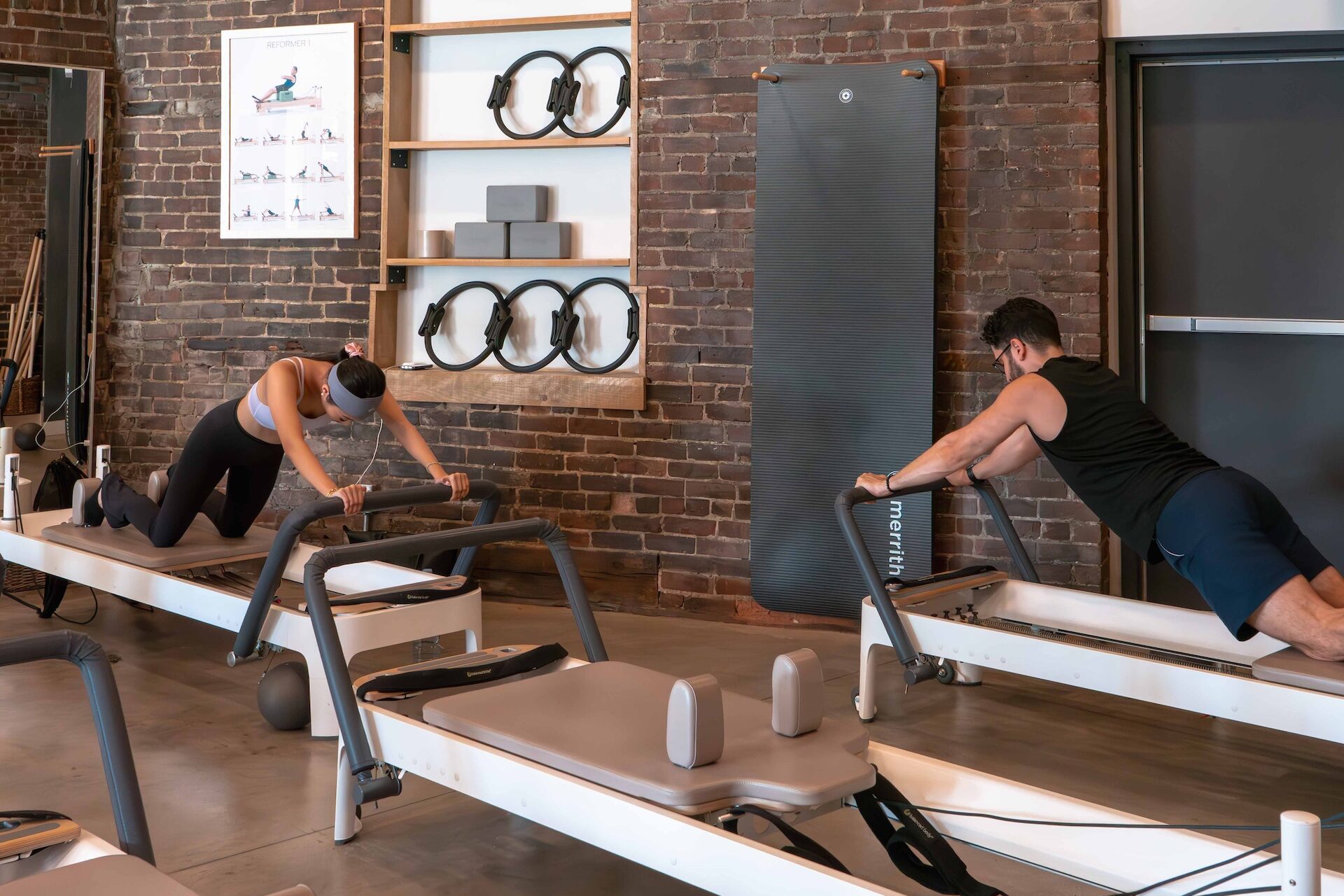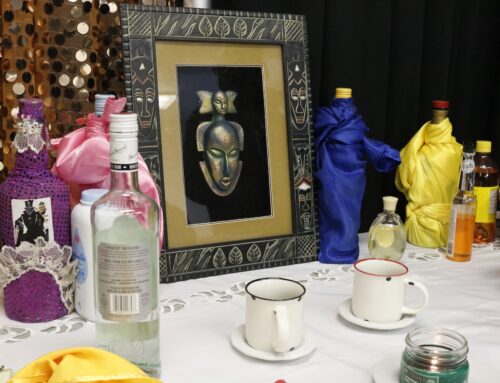BY Adamante Balin
In a small, dimly lit bedroom, a light blue yoga mat stretches across the floor. A laptop playing a YouTube video serves as the guide to Tasnim Boudizi’s personal studio. There is no sleek equipment, no mirrors reflecting rows of synchronized bodies, just a quiet space where she unrolls herself from the day’s weight. A few feet away, a pile of textbooks looms, but for now, they remain untouched.
“When I get home at the end of the day, it’s my favourite time,” she says. “It’s very relaxing. I can stretch, cool down – it’s just a relief from all the stress that I can have during the day.”
Boudizi’s movement practice has evolved over the years. A former competitive swimmer, judoka, gymnast, and rhythmic gymnast, she spent years in high-level athletics, chasing strength and precision. But injuries forced her to rethink her relationship with fitness. Seeking something calmer—something that could help her navigate academic stress—she stumbled into a Pilates studio near her home and decided to walk in.
Now she combines at-home routines and studio classes in Swiss Ball Pilates and Warrior Yoga. Still, despite the personal solace she says she’s found, Boudizi says she remains conscious of the visual culture surrounding Pilates.
“I don’t relate to most of what I see on social media,” she says. “Everything is pink and extreme—it doesn’t reflect my daily practice.”
As Pilates has surged in popularity, so has the imagery that accompanies it.
Nutritionist Myriam Beaudry says that a decade ago, the dominant fitness trend revolved around sculpting curves. The early 2010s saw an explosion of gym culture, heavily influenced by celebrities like Kim Kardashian.
Beaudry says that at this time, high-intensity workouts and weightlifting were emphasized to achieve a muscular, hourglass physique.
“You had to be lean, to have a certain firmness and apparent muscles without being too muscular.” She says that the Brazilian Butt Lift’s (BBL) rise to popularity reflects this pursuit of a strong yet voluptuous body.
A timeline shows the evolution of the Western “ideal feminine body” from the early 20th to today. Infographic by Adamante balin.
Beaudry says the current wave favours a leaner look—one that aligns with the promise of lengthening and refinement of practices like Yoga, barre, and Pilates. The demand for these regimes is reflected in the number of Pilates and Yoga studios which are growing rapidly. Marketing research company Research Dive suggests a growth of 10 per cent from 2021 to 2028.
Boudizi has felt these shifts firsthand.
“I never started Pilates to lose weight,” she says, “But I would define my body as more of the Kardashian type, because I was focusing on heavy training as an athlete. My shoulders are very broad and muscular, I also have a well-rounded posterior.”
Boudizi has also felt pressured to change her body based on how other Pilates practitioners look.
“Now it’s harder, as I see only thin, skinny, stereotypes around me, I’m like, ‘Oh, should I lose weight?’ When I am at a Pilates class, sometimes I look at all of the ladies next to me and think, ‘Should I go towards that? You know, should it be a goal?’”
A 2008 survey by Ipsos-Reid found that 73 per cent of women in Quebec want to lose weight, with 62 per cent citing social pressure as the primary driver. Aisha Fairclough, the co-founder of the non-profit organization Body Confidence Canada, says that shifts in terminology, from “weight loss” to “wellness,” do not change the underlying expectation: A thinner body remains the desirable one.
“The fitness industry is built on people’s insecurities. That’s how they make money. Everybody wants to look better because if you look better, you’re going to feel better, right?,” Fairclough says.
“When you think of wellness you think of being thin, because that’s what a productive body looks like.”
Jade Barazin is a Pilates instructor and the manager of Roze Studio in the Old Port. While other studios rarely frame their messaging around weight loss outright, she says she has noticed that the language used, such as sculpt, tone, and elongate, still implies an idealized physique, leaving some people out.
“I feel like nowadays, people market their studios like, ‘You’ll feel the burn and the shakes,’” Barazin says. “But if you’re someone coming in after an injury, you broke an ankle and you’re trying to restore, and all you are seeing are these small girls, tiny blondes or brunettes, but you need help, you wanna walk, you wanna get your strength again, you will feel like this is not the place for you.”
Online, Barazin says Pilates is marketed as a lifestyle rather than just exercise. She says the aesthetic surrounding it—minimalist studios, neutral tones, premium workout sets— is problematic, as it adds to an exclusivity that can make outsiders feel unwelcome.

Jade Barazin, manager of Roze Pilates, observes from the front desk as a reformer Pilates instructor leads a class at the studio in Montreal’s Old Port. Barazin has been an instructor for two years and has managed the studio since it opened in 2022. Photo by Adamante Balin.
“We’re so much more than that, it’s so much more than dressing up in pink,” she says. “It’s more about pushing your practice and less about coming once a week just to post a story.”
Boudizi says she initially felt a lot of discomfort surrounding this aestheticization of Pilates and Yoga.
“At first, I was really pressuring myself into changing my physical appearance. I would always have nice hairstyles and make sure I smell like a sweet candy before I go,” she says. “I am used to very intense sports, where you sweat a lot and you don’t care about your physical appearance. So this was hard at the beginning because I would sweat at the end of the workout and think ‘Oh, I do not fit in this.’”

Cihan Dandul, a Pilates and barre instructor, demonstrates movements on the reformer machine at Roze Studio in Montreal’s Old Port. Once a brewery, the space retains its original red brick walls, chandeliers, and counter—an aesthetic choice by founder Justine Rozon. Photo by Adamante Balin.
Beyond exercise, the pursuit of thinness has increasingly intersected with medicine. Ozempic, a drug originally intended for Type 2 diabetes, has seen a sharp rise in off-label use for weight loss. According to data from the RAMQ, in Quebec alone, more than 68,543 people were prescribed Ozempic for non-diabetic weight loss last year—compared to just 254 in 2019.
Dr. Julie St-Pierre, endocrinologist, highlights the ethical concerns surrounding this trend.
“For individuals with clinical obesity, Ozempic can be beneficial, reducing cardiovascular risks by 20 per cent,” she says.
“But we need to have a complete evaluation of the case. We do not prescribe it for aesthetic reasons, or because we want to model and go on runways. The issue is that around the world, we are seeing misuses, which increases our aversion towards this medicine.”
St-Pierre says that medications like Ozempic require a comprehensive approach, involving a team of healthcare professionals—including a nutritionist, doctor, nurse, therapist, and endocrinologist—to help manage side effects such as nausea, irritation, and abdominal pain.
“The issue is that these multidisciplinary teams are not supported by the government of Quebec,” she says. “Many doctors will prescribe Ozempic and say, ‘Here you go, I satisfy your demand, let’s see each other in a year,’ which can lead to complications.”
According to Beaudry, this rise in pharmaceutical solutions for weight management mirrors the fixation on thinness for women, which she says has deep historical roots.
“After World War II, we saw the emergence of thinness as a beauty standard,” she says. “What was argued by sociologists at the time was that putting women in a position where they need to focus on their body image and their diet is a way to take their attention away from more important things like gaining more rights.”

Ezri Cusson, Pilates instructor, leads a private class for two practitioners in Roze Pilates in Montreal’s Old Port neighbourhood. Photo by Adamante Balin.
To move forward, Fairclough says she believes we should redefine wellness itself completely.
“Truly, if you want to, there’s many ways to be well. You don’t need expensive clothing, these great yoga pants, that cute bra, or certain running shoes. You don’t need that,” she says. “If you want to be well, you need yourself, a book at the library, a candle, a quiet space.”
She says this redefinition would allow more inclusivity and representation in fitness, without economic or morphological barriers.
“When you see yourself, it changes your life, you want to be there, so it’s so important for companies to have images that show all body types. If you don’t [see yourself], sometimes you’ve gotta insert yourself there. But it does take courage to try things when you don’t see yourself in a space.”
Beaudry believes that true wellness must be disentangled from body ideals, shifting focus from aesthetics to function. A 2021 study by Science Direct indicates that body satisfaction among women aged 70-74 is 14 per cent higher than that of women aged 19-24, as the former start prioritizing health over appearance.

Cihan Dandul leads a reformer Pilates class at Roze Studio in Montreal’s Old Port. Photo by Adamante Balin.
“Instead of asking, ‘How do I look?’ ask, ‘What do I want my body to do?’ Whether that’s biking with friends or maintaining mobility to age well—goals should be practical, not just visual,” she says.
“Life is happening now, not five kilos from now.”




